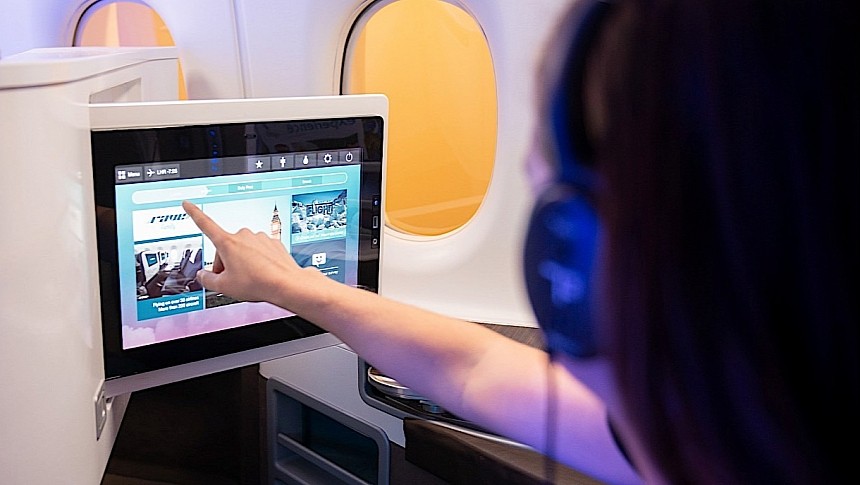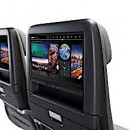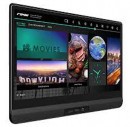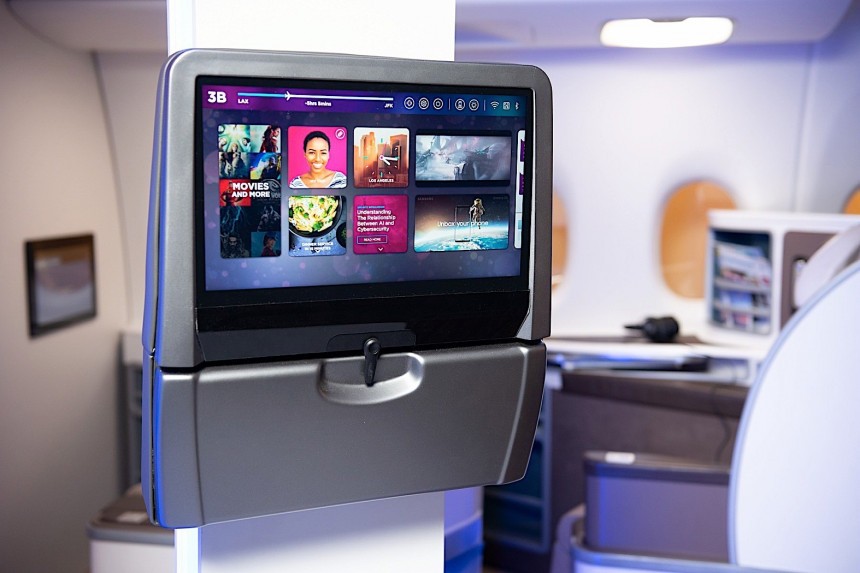Passenger flights are so common these days that it's almost impossible to find a person in the civilized world who hasn't set foot inside an airplane and took a longer or shorter flight. But with commonality also comes boredom, and given how frequently some of us take to the sky, looking out the window and marveling at the vistas below simply doesn't cut it anymore.
This is where in-flight entertainment systems come in. Included in the flight experience not long ago, they mostly come as screens and headsets used to bring movies, music, and whatnot to each passenger depending on needs, wants, and likes. All with the goal of making flight time go by faster, and please as many airline customers as possible.
There are several types of in-flight entertainment systems currently being used. The most common come as simple screens that only show the airplane's progress on its flight path through moving maps. Then, we have audio entertainment, which can manifest itself as music or news.
Then, there's the entertainment of the video variety, which can be either a single-screen, shared experience between all passengers on a flight, or a more personal, almost tailored-to-each-individual one.
And, finally, as the ultimate expression of evolution in this field, video games too are making their way into airplanes, literally making time fly on long-haul flights.
All of the above is run on a variety of hardware, supplied by a variety of electronics companies. There are few integrated in-flight entertainment systems, and the ones made by a company called Safran are a solid part of that short list.
Safran's first such solution was called the RAVE Seat-Centric system, and it has been around since 2011. It is centered on a System Control Unit (SCU), screens, and an SD card installed in each seat. It not only provides wireless visual and audio entertainment by means of touchscreen displays, but also connectivity and a series of digital services, like advertising and analytics.
The system is so popular it already is in use in thousands of airplanes doing the rounds in the skies of the world. But, as it often happens in this industry, the RAVE is rapidly getting old, and updates have to regularly be made.
A few years ago, Safran introduced the RAVE Ultra, and earlier in June 2023 it let loose the first details of the RAVE Ultra Plus. It's this latter tech we're here to look at now, in an attempt to get a better idea of what the future of airborne fun might look like.
The new tech builds upon the previous two and just like them it targets low weight (a constant concern for airlines), high power, and an exciting experience.
Despite the Plus in the name, the new RAVE system actually brings a decrease in weight compared to the Ultra. By optimizing cable weights and cutting down on the number of wires, the new system should be up to 23 percent lighter than the previous version.
The system can be installed on a variety of passenger aircraft because it was made in such a way as to be compatible from the get-go with most of them, especially when it comes to the cables used to wire it.
Like all other such technologies out there, the RAVE has both a hardware and a software component. We'll look at them separately to try to give you a clearer picture of what it's all about.
There are several pieces of hardware that make up the RAVE, including the above-mentioned wires and cables, but of interest to us today are the screens and the plugs.
On the screen front, the RAVE Ultra Plus comes as 4K Ultra High-Definition displays packing mini LED Liquid Crystal Display (LCD) tech. This solution was chosen because LCDs have always worked well for airplane screens.
Mini LEDs offer the best brightness and contrast options, and both are important in an environment where the Sun almost always shines and the window passenger sometimes refuses to close the shade. LEDs also allow zone dimming and support High Dynamic Range (HRD) content.
The dimensions of the screen for the new RAVE were not announced, but the company making them will probably focus on larger sizes that go into premium cabins. Safran says the screens should start rolling into airplanes as soon as 2025.
What the new RAVE will probably be remembered for is how many plugs it offers. Safran says all personal devices can be charged in any cabin class through a DC power system installed in each seat. The maximum USB-C fast charging capacity per passenger is 60 w.
Although it's unlikely many of us will need AC charging in an airplane in the near future, RAVE Ultra Plus will offer that as well. AC outlets installed in every seat will help with that, and they'll draw power not from a seat power box, but from AC outlets located elsewhere in the plane – something that's never been done before in the industry according to Safran.
Safran does not say exactly what features and apps the OS offers from the get-go, but given how it's an Open Software Platform, it will allow parties with an interest in doing so to develop apps that can be run on the RAVE OS, depending on needs and what the airlines want to offer their passengers. The software will also provide cloud services thanks to a collaboration Safran has with Amazon Web Services.
A timetable for the rollout of the first RAVE Ultra Plus systems was not announced, but I think it's safe to say the year Safran mentioned in relation to the new screens, 2025, is the birth year of this new in-flight entertainment system.
There are several types of in-flight entertainment systems currently being used. The most common come as simple screens that only show the airplane's progress on its flight path through moving maps. Then, we have audio entertainment, which can manifest itself as music or news.
Then, there's the entertainment of the video variety, which can be either a single-screen, shared experience between all passengers on a flight, or a more personal, almost tailored-to-each-individual one.
And, finally, as the ultimate expression of evolution in this field, video games too are making their way into airplanes, literally making time fly on long-haul flights.
All of the above is run on a variety of hardware, supplied by a variety of electronics companies. There are few integrated in-flight entertainment systems, and the ones made by a company called Safran are a solid part of that short list.
Safran's first such solution was called the RAVE Seat-Centric system, and it has been around since 2011. It is centered on a System Control Unit (SCU), screens, and an SD card installed in each seat. It not only provides wireless visual and audio entertainment by means of touchscreen displays, but also connectivity and a series of digital services, like advertising and analytics.
A few years ago, Safran introduced the RAVE Ultra, and earlier in June 2023 it let loose the first details of the RAVE Ultra Plus. It's this latter tech we're here to look at now, in an attempt to get a better idea of what the future of airborne fun might look like.
The new tech builds upon the previous two and just like them it targets low weight (a constant concern for airlines), high power, and an exciting experience.
Despite the Plus in the name, the new RAVE system actually brings a decrease in weight compared to the Ultra. By optimizing cable weights and cutting down on the number of wires, the new system should be up to 23 percent lighter than the previous version.
The system can be installed on a variety of passenger aircraft because it was made in such a way as to be compatible from the get-go with most of them, especially when it comes to the cables used to wire it.
Like all other such technologies out there, the RAVE has both a hardware and a software component. We'll look at them separately to try to give you a clearer picture of what it's all about.
Hardware
On the screen front, the RAVE Ultra Plus comes as 4K Ultra High-Definition displays packing mini LED Liquid Crystal Display (LCD) tech. This solution was chosen because LCDs have always worked well for airplane screens.
Mini LEDs offer the best brightness and contrast options, and both are important in an environment where the Sun almost always shines and the window passenger sometimes refuses to close the shade. LEDs also allow zone dimming and support High Dynamic Range (HRD) content.
The dimensions of the screen for the new RAVE were not announced, but the company making them will probably focus on larger sizes that go into premium cabins. Safran says the screens should start rolling into airplanes as soon as 2025.
What the new RAVE will probably be remembered for is how many plugs it offers. Safran says all personal devices can be charged in any cabin class through a DC power system installed in each seat. The maximum USB-C fast charging capacity per passenger is 60 w.
Although it's unlikely many of us will need AC charging in an airplane in the near future, RAVE Ultra Plus will offer that as well. AC outlets installed in every seat will help with that, and they'll draw power not from a seat power box, but from AC outlets located elsewhere in the plane – something that's never been done before in the industry according to Safran.
Software
Powering the entire entertainment system is something called RAVE OS. It's an operating system developed in-house by Safran and its partners specifically for use in this kind of hardware.Safran does not say exactly what features and apps the OS offers from the get-go, but given how it's an Open Software Platform, it will allow parties with an interest in doing so to develop apps that can be run on the RAVE OS, depending on needs and what the airlines want to offer their passengers. The software will also provide cloud services thanks to a collaboration Safran has with Amazon Web Services.
A timetable for the rollout of the first RAVE Ultra Plus systems was not announced, but I think it's safe to say the year Safran mentioned in relation to the new screens, 2025, is the birth year of this new in-flight entertainment system.










